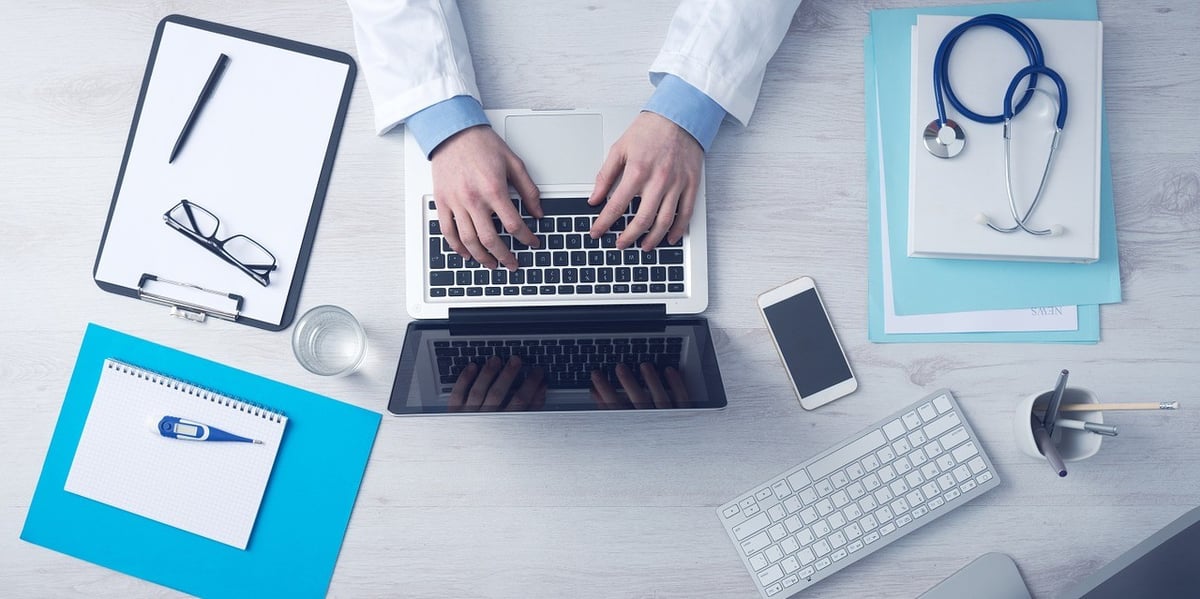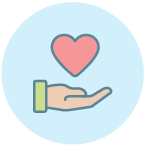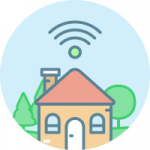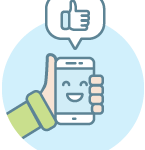
Get ready for IoMT: the Internet of Medical Things
Internet of Medical Things includes devices that are used for medical purposes. Let's examine some exciting IoMT projects and how they are changing lives.
Luke Bouma
Jan 24, 2019
The Internet of Things is revolutionizing the medical field so fast; it even has its own abbreviations. The Internet of Medical Things, or the Internet of Heath Things (IoMT and IoHT for short), is a network of medical devices that provides better access to data. Data that can enable and inform both patients and providers alike. With access to the information that IoMT provides, we can expect to see an improvement in patient outcome, lowered cost of care, an increase in preventive care, better management of medical assets, and an increase in the quality of life for the elderly and disabled. Let's examine several exciting IoMT projects and how they are changing lives. First, some definitions: IoMT is a sub-group of the Internet of Things (IoT). IoT is comprised of all devices that have access to the web, while IoMT only includes the devices that are used for medical purposes. IoMT devices often utilize sensor technology, artificial intelligence, mobile apps, and networks like Wi-Fi, Bluetooth, and LTE.
 The Internet of Things can be found everywhere in hospitals, from tags that prevent baby theft and misplacement, to smart beds that prevent bed sores and monitor vitals, the list of IoT devices and their uses in hospitals could go on forever. Many of these devices take advantage of Real-Time Location Systems (RTLS). RTLS can be thought of as an indoor GPS for hospitals but instead of using satellite data, RTLS takes advantage of sensor technologies, various tags/badges, and Wi-Fi/Bluetooth, to provide remote monitoring and data analysis. They all come together to improve patient care and safety. AutoBed is one example of a RTLS. AutoBed is a program developed by GE, and according to this BBC article, the AutoBed helped a New York hospital reduce its emergency department waiting time in half. AutoBed uses algorithms that use medical records and real-time data (from IoT devices) of which hospital beds are available, to match the best possible bed for the patient while maximizing the hospital’s resources. Other RTLS include Zanthion and Sensor Metrix. Zanthion uses wearable devices on patients’ clothes for remote patient monitoring. Zanthion systems will send an alert if the patient falls off the bed or remains motionless for too long. Sensor Metrix uses sensors located in refrigerators, freezers and laboratories to ensure blood samples and medications are kept at an accurate temperature.
The Internet of Things can be found everywhere in hospitals, from tags that prevent baby theft and misplacement, to smart beds that prevent bed sores and monitor vitals, the list of IoT devices and their uses in hospitals could go on forever. Many of these devices take advantage of Real-Time Location Systems (RTLS). RTLS can be thought of as an indoor GPS for hospitals but instead of using satellite data, RTLS takes advantage of sensor technologies, various tags/badges, and Wi-Fi/Bluetooth, to provide remote monitoring and data analysis. They all come together to improve patient care and safety. AutoBed is one example of a RTLS. AutoBed is a program developed by GE, and according to this BBC article, the AutoBed helped a New York hospital reduce its emergency department waiting time in half. AutoBed uses algorithms that use medical records and real-time data (from IoT devices) of which hospital beds are available, to match the best possible bed for the patient while maximizing the hospital’s resources. Other RTLS include Zanthion and Sensor Metrix. Zanthion uses wearable devices on patients’ clothes for remote patient monitoring. Zanthion systems will send an alert if the patient falls off the bed or remains motionless for too long. Sensor Metrix uses sensors located in refrigerators, freezers and laboratories to ensure blood samples and medications are kept at an accurate temperature.
 Most smart home projects use IoT devices to help with things like security or lighting. While Medical Smart homes focus on providing remote medical monitoring, preventive care, and provides cheaper and easier access to healthcare for the elderly and disabled. Ting is very familiar with Medical Smart homes through its partnership with Mid-Atlantic Gigabit Innovation Collaboratory (MAGIC) and its MAGIC Medical Smart Home Project . Ting provides Internet service to MAGIC’s two Smart Homes. For more information on Ting’s partnership with MAGIC and how Smart Homes are changing lives, follow the link to our blog. .
Most smart home projects use IoT devices to help with things like security or lighting. While Medical Smart homes focus on providing remote medical monitoring, preventive care, and provides cheaper and easier access to healthcare for the elderly and disabled. Ting is very familiar with Medical Smart homes through its partnership with Mid-Atlantic Gigabit Innovation Collaboratory (MAGIC) and its MAGIC Medical Smart Home Project . Ting provides Internet service to MAGIC’s two Smart Homes. For more information on Ting’s partnership with MAGIC and how Smart Homes are changing lives, follow the link to our blog. .
 Wearable devices have become so familiar that mentioning FitBits and other wearable healthcare devices would be boring. However, there are more exciting, and more SciFi like devices out there. Researches are developing contact lenses that measure blood sugar levels by analyzing patients’ tears, and electronic pills that can send information from the gut to the phone. Smart contact lenses might one day offer an alternative way of measuring glucose levels. Instead of pricking a finger, these IoMT contacts use their transparent sensors to measure very small concentrations of glucose that can be found in tears. The data from the tears can be collected by the lens and then sent to a smartphone or other devices. Researchers hope that these contact lenses might be able to monitor kidney and liver diseases, along with other conditions in the future. Digital pills or “smart pills” are grain-sized sensors that can be digested. Once digested, these devices can collect data and then send that data back to a smartphone. This might sound like science fiction, but digital pills have already hit the market place. In 2017 the FDA approved the first-ever digital pill called Abilify MyCite. The pill has an embedded sensor that records the time and date the pill is taken.
Wearable devices have become so familiar that mentioning FitBits and other wearable healthcare devices would be boring. However, there are more exciting, and more SciFi like devices out there. Researches are developing contact lenses that measure blood sugar levels by analyzing patients’ tears, and electronic pills that can send information from the gut to the phone. Smart contact lenses might one day offer an alternative way of measuring glucose levels. Instead of pricking a finger, these IoMT contacts use their transparent sensors to measure very small concentrations of glucose that can be found in tears. The data from the tears can be collected by the lens and then sent to a smartphone or other devices. Researchers hope that these contact lenses might be able to monitor kidney and liver diseases, along with other conditions in the future. Digital pills or “smart pills” are grain-sized sensors that can be digested. Once digested, these devices can collect data and then send that data back to a smartphone. This might sound like science fiction, but digital pills have already hit the market place. In 2017 the FDA approved the first-ever digital pill called Abilify MyCite. The pill has an embedded sensor that records the time and date the pill is taken.
IoMT in hospitals
 The Internet of Things can be found everywhere in hospitals, from tags that prevent baby theft and misplacement, to smart beds that prevent bed sores and monitor vitals, the list of IoT devices and their uses in hospitals could go on forever. Many of these devices take advantage of Real-Time Location Systems (RTLS). RTLS can be thought of as an indoor GPS for hospitals but instead of using satellite data, RTLS takes advantage of sensor technologies, various tags/badges, and Wi-Fi/Bluetooth, to provide remote monitoring and data analysis. They all come together to improve patient care and safety. AutoBed is one example of a RTLS. AutoBed is a program developed by GE, and according to this BBC article, the AutoBed helped a New York hospital reduce its emergency department waiting time in half. AutoBed uses algorithms that use medical records and real-time data (from IoT devices) of which hospital beds are available, to match the best possible bed for the patient while maximizing the hospital’s resources. Other RTLS include Zanthion and Sensor Metrix. Zanthion uses wearable devices on patients’ clothes for remote patient monitoring. Zanthion systems will send an alert if the patient falls off the bed or remains motionless for too long. Sensor Metrix uses sensors located in refrigerators, freezers and laboratories to ensure blood samples and medications are kept at an accurate temperature.
The Internet of Things can be found everywhere in hospitals, from tags that prevent baby theft and misplacement, to smart beds that prevent bed sores and monitor vitals, the list of IoT devices and their uses in hospitals could go on forever. Many of these devices take advantage of Real-Time Location Systems (RTLS). RTLS can be thought of as an indoor GPS for hospitals but instead of using satellite data, RTLS takes advantage of sensor technologies, various tags/badges, and Wi-Fi/Bluetooth, to provide remote monitoring and data analysis. They all come together to improve patient care and safety. AutoBed is one example of a RTLS. AutoBed is a program developed by GE, and according to this BBC article, the AutoBed helped a New York hospital reduce its emergency department waiting time in half. AutoBed uses algorithms that use medical records and real-time data (from IoT devices) of which hospital beds are available, to match the best possible bed for the patient while maximizing the hospital’s resources. Other RTLS include Zanthion and Sensor Metrix. Zanthion uses wearable devices on patients’ clothes for remote patient monitoring. Zanthion systems will send an alert if the patient falls off the bed or remains motionless for too long. Sensor Metrix uses sensors located in refrigerators, freezers and laboratories to ensure blood samples and medications are kept at an accurate temperature.
Medically smart homes
 Most smart home projects use IoT devices to help with things like security or lighting. While Medical Smart homes focus on providing remote medical monitoring, preventive care, and provides cheaper and easier access to healthcare for the elderly and disabled. Ting is very familiar with Medical Smart homes through its partnership with Mid-Atlantic Gigabit Innovation Collaboratory (MAGIC) and its MAGIC Medical Smart Home Project . Ting provides Internet service to MAGIC’s two Smart Homes. For more information on Ting’s partnership with MAGIC and how Smart Homes are changing lives, follow the link to our blog. .
Most smart home projects use IoT devices to help with things like security or lighting. While Medical Smart homes focus on providing remote medical monitoring, preventive care, and provides cheaper and easier access to healthcare for the elderly and disabled. Ting is very familiar with Medical Smart homes through its partnership with Mid-Atlantic Gigabit Innovation Collaboratory (MAGIC) and its MAGIC Medical Smart Home Project . Ting provides Internet service to MAGIC’s two Smart Homes. For more information on Ting’s partnership with MAGIC and how Smart Homes are changing lives, follow the link to our blog. .
IoMT for the body
 Wearable devices have become so familiar that mentioning FitBits and other wearable healthcare devices would be boring. However, there are more exciting, and more SciFi like devices out there. Researches are developing contact lenses that measure blood sugar levels by analyzing patients’ tears, and electronic pills that can send information from the gut to the phone. Smart contact lenses might one day offer an alternative way of measuring glucose levels. Instead of pricking a finger, these IoMT contacts use their transparent sensors to measure very small concentrations of glucose that can be found in tears. The data from the tears can be collected by the lens and then sent to a smartphone or other devices. Researchers hope that these contact lenses might be able to monitor kidney and liver diseases, along with other conditions in the future. Digital pills or “smart pills” are grain-sized sensors that can be digested. Once digested, these devices can collect data and then send that data back to a smartphone. This might sound like science fiction, but digital pills have already hit the market place. In 2017 the FDA approved the first-ever digital pill called Abilify MyCite. The pill has an embedded sensor that records the time and date the pill is taken.
Wearable devices have become so familiar that mentioning FitBits and other wearable healthcare devices would be boring. However, there are more exciting, and more SciFi like devices out there. Researches are developing contact lenses that measure blood sugar levels by analyzing patients’ tears, and electronic pills that can send information from the gut to the phone. Smart contact lenses might one day offer an alternative way of measuring glucose levels. Instead of pricking a finger, these IoMT contacts use their transparent sensors to measure very small concentrations of glucose that can be found in tears. The data from the tears can be collected by the lens and then sent to a smartphone or other devices. Researchers hope that these contact lenses might be able to monitor kidney and liver diseases, along with other conditions in the future. Digital pills or “smart pills” are grain-sized sensors that can be digested. Once digested, these devices can collect data and then send that data back to a smartphone. This might sound like science fiction, but digital pills have already hit the market place. In 2017 the FDA approved the first-ever digital pill called Abilify MyCite. The pill has an embedded sensor that records the time and date the pill is taken.
.png?length=710&name=Blog%20banners%20(12).png)
.png?length=710&name=Prizm%20template%20(3).png)
.png?length=710&name=Blog%20banners%20(10).png)